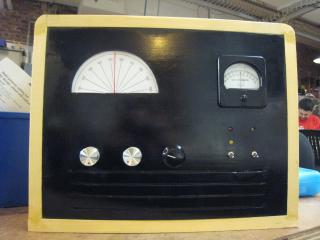
David MIller
Jason Aston
Lucas Werthein
Historical Radio
A radio which moves the listener through time and space

Classes
Introduction to Physical Computing
Introduction to Physical Computing
The historical radio uses a familiar interface to navigate through historical radio broadcasts from multiple genres of music and news. The tracks are curated to provide an educational experience, highlighting events across time (move through time) or across the world and genres at the same time (move through space).
This device would fit in at a history museum, and is designed to be understandable and usable by anone who has ever used a radio: turn the tuning knob to move through time, turn the band selector switch to move through space. By selecting an automatic mode, the curation will take the listener along a path across time or space.
Background
I researched 1930s-1950s radio designs--particularly Raymond Loewy's designs for Hallicrafters from the 1940s and 1950s. To curate the tracks played, I researched radio history, and spent a great deal of time finding historical radio broadcast recordings and important songs to load onto the MP3 trigger.
Audience
The intended audience is museum attendees (or gallery show attendees). the device is usable by all ages, and the tracks chosen are appropriate for all ages as well.
User Scenario
A user would turn the radio on, select a starting band and tune to a marker on the dial denoting a historical event or person of note. From there, dependent on the settings selected, the radio will play a curated set of tracks related to the starting point, moving through time or space
Implementation
The case is made of hardwood, with a lacquered masonite front panel. This is similar to radios of the 1920s and 1930s in construction. Inside is an Arduino Mega, controlling a geared servo for 360 degree rotation of the tuning dial and a set of LEDs for the band indicators. A galvanometer is driven by an H-Bridge for the tuning indicator. A Robertsonics MP3 Trigger provides sound output.
Conclusion
As Prof. Igoe said at the beginning of this endeavour, interaction is the key issue, even more than hardware and software design. Technical problems were not insignificant, as the MP3 Trigger failed right before midterms, and the two-dimensional interactivity is not trivial to code. As always, things do take several times longer than expected, and hardware/software has led to some interesting behavior. Starting this relatively green, I have become much stronger with my programmatic thinking and hardware design skills.
Notable lessons include: design for disassembly and repair. As much as trying to make things elegant and compact is fine when it's mass-produced and once out of the factory done with. A burned-out LED in the middle of a block of things is an annoyance to disassemble.
This device would fit in at a history museum, and is designed to be understandable and usable by anone who has ever used a radio: turn the tuning knob to move through time, turn the band selector switch to move through space. By selecting an automatic mode, the curation will take the listener along a path across time or space.
Background
I researched 1930s-1950s radio designs--particularly Raymond Loewy's designs for Hallicrafters from the 1940s and 1950s. To curate the tracks played, I researched radio history, and spent a great deal of time finding historical radio broadcast recordings and important songs to load onto the MP3 trigger.
Audience
The intended audience is museum attendees (or gallery show attendees). the device is usable by all ages, and the tracks chosen are appropriate for all ages as well.
User Scenario
A user would turn the radio on, select a starting band and tune to a marker on the dial denoting a historical event or person of note. From there, dependent on the settings selected, the radio will play a curated set of tracks related to the starting point, moving through time or space
Implementation
The case is made of hardwood, with a lacquered masonite front panel. This is similar to radios of the 1920s and 1930s in construction. Inside is an Arduino Mega, controlling a geared servo for 360 degree rotation of the tuning dial and a set of LEDs for the band indicators. A galvanometer is driven by an H-Bridge for the tuning indicator. A Robertsonics MP3 Trigger provides sound output.
Conclusion
As Prof. Igoe said at the beginning of this endeavour, interaction is the key issue, even more than hardware and software design. Technical problems were not insignificant, as the MP3 Trigger failed right before midterms, and the two-dimensional interactivity is not trivial to code. As always, things do take several times longer than expected, and hardware/software has led to some interesting behavior. Starting this relatively green, I have become much stronger with my programmatic thinking and hardware design skills.
Notable lessons include: design for disassembly and repair. As much as trying to make things elegant and compact is fine when it's mass-produced and once out of the factory done with. A burned-out LED in the middle of a block of things is an annoyance to disassemble.

